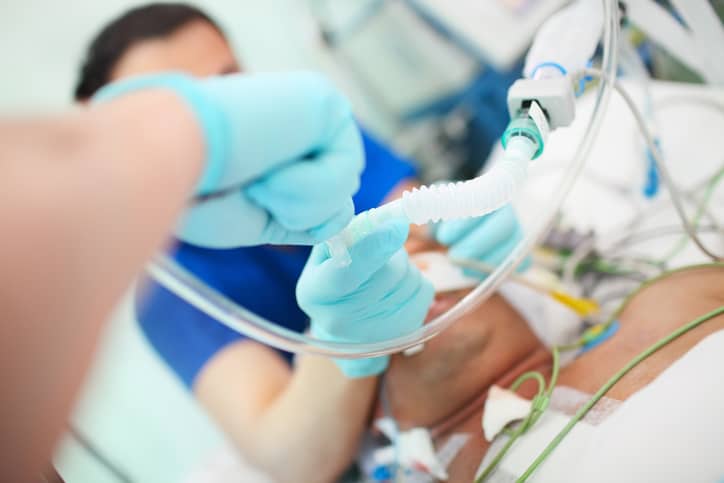Critical care nursing is an exciting and challenging specialty for healthcare providers. There are many different types of critical care units including emergency medicine, intensive care units, labor and delivery, and flight nursing. Nurses who work in these types of environments must be able to think critically, stay calm in a crisis, help families cope with extreme stress, and sometimes manage end-of-life care. A critical care nurse often specializes and chooses to work in trauma centers, burn units, cardiac care, or acute stroke centers. When they specialize, critical care nurses can focus on a specific type of patient and become experts in their chosen area.
Related: Critical Care/Emergency Specialty CE Courses for Nursing Professionals
Trauma care basics for the critical care nurse
Trauma patients may be admitted to the emergency department or intensive care unit due to motor vehicle accidents, assaults, falls, or other injuries. Nurses working with trauma patients must know how to manage everything from severe head or spinal cord injuries to thoracic trauma and bleeding.
The first goal of the trauma team is always to assess for the worst injuries and stop the patient from sustaining further harm. This may mean stabilizing the spinal cord, stopping bleeding, protecting the airway, or getting the patient to the operating room.
Trauma nurses should always start with a trauma assessment, and focus on the ABCDE of a trauma assessment. ABCDE stands for:
- Airway
- Breathing
- Circulation
- Disability
- Exposure
Airway
Loss of airway is a common cause of death in many trauma patients. First responders and nurses should always ensure that the airway is open and that air can pass from the mouth, through the trachea, and into the lungs. Facial trauma, foreign objects, and a decreased level of consciousness can all cause an obstructed airway.
Breathing
Once an airway has been established, caregivers assist the patient with their breathing. For patients who are alert and awake, supplemental oxygen may be sufficient. For patients with decreased levels of consciousness or extremely high oxygen needs, intubation and mechanical ventilation may be required.
Circulation
If the patient has a clear airway and is getting sufficient oxygen and ventilation through the lungs, the care team can move on to assessing the patient’s circulation. Adequate circulation requires enough volume, or blood, functioning cardiac muscle, and enough vascular tone to get the blood where it needs to go.
Nurses can help a patient’s circulation by giving volume in the form of IV fluids or blood products, using medications to increase cardiac contractility or vascular tone, or suggesting a mechanical circulatory device such as an Impella or ECMO.
Disability
After assessing the airway, breathing, and circulation, check the patient for good neurological function. This can include an assessment of the patient’s level of consciousness, motor function, and sensation.
Exposure
Once the patient is relatively stable, the care team can move on to the assessment and care of other injuries. These may include spinal cord injuries, head injuries, broken limbs, or other non-life-threatening emergencies
Cardiac care
Nurses can also specialize in cardiac critical care. This may include caring for patients with severe heart failure, after a myocardial infarction, or postoperative cardiac and thoracic patients. Cardiac care nurses must be familiar with all types of heart rhythms, cardiac medications, and mechanical circulatory support devices.
Devices commonly used in cardiac critical care include extracorporeal membrane oxygenation (ECMO), left ventricular assist device (LVAD), Impella, total artificial heart, and intra-aortic balloon pump (IABP). Most of these devices require specialized training and some hospitals require specific certifications to care for these types of cardiac support devices.
Stroke care
Nurses who work in a neuro-ICU may frequently care for patients who have suffered a stroke. Strokes can be:
- Ischemic: Root cause, blockage;
- Hemorrhagic: Root cause, bleeding;
- Embolic: Root cause, either an air embolus or another type of growth
Stroke patients are at a high risk of devastating disability and death. Treat strokes quickly and recognize that they require frequent follow-up assessments. Report any changes in neurologic status to the physician immediately.
Shock
Every critical care nurse should be familiar with the different types of shock. This includes causes and the treatments. Types of shock include:
- Hypovolemic: A rapid loss of fluid from the body causes this kind of shock. Most often, hemorrhage causes hypovolemic shock. Care providers must first stop the fluid loss and replace what is lost with appropriate fluids. This may mean giving fluids, blood products, or a combination of both.
- Distributive: Vasodilation causes distributive shock. Sepsis, anaphylaxis, or spinal cord injuries may cause vasodilation. Clinicians can treat this kind of shock with fluids and vasopressor medications.
- Cardiogenic: A heart that fails to pump blood effectively causes this kind of shock. Patients in cardiogenic shock need inotropic medications and sometimes support devices. Fluids, unfortunately, can make cardiogenic shock worse.
- Obstructive: Obstructive shock is the least common type. Some form of physical obstruction causes obstructive shock. This could be a result of bleeding inside the chest or a pulmonary embolism.
End-of-life care
Unfortunately, critical care nurses cannot save the life of every patient that they care for. Almost every critical care nurse will have to manage a patient’s end of life care at some point in their career.
End-of-life care involves keeping both the patient and their loved ones calm and comfortable as death approaches. In critical care areas, this often means the nurse has to turn off machines and medications that are keeping the patient alive. This can be a difficult task, especially for a nurse who has gotten to know a patient and their loved ones.
Often, resources like a palliative care team and hospital chaplain can make the process easier. Nurses should also remember to practice good self-care after the loss of a patient.





